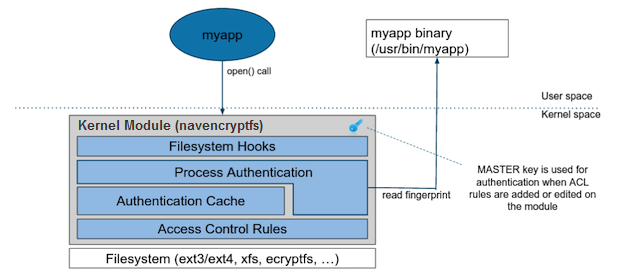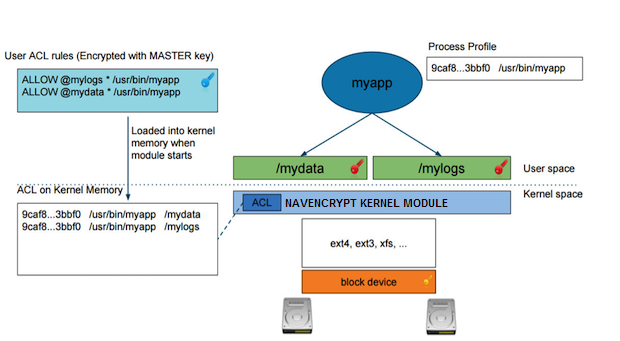Process-Based Access Control List
The access control list (ACL) controls access to specified data. The ACL uses a process fingerprint, which is the SHA256 hash of the process binary, for authentication. You can create rules to allow a process to access specific files or directories. The ACL file is encrypted with the client master key and stored locally for quick access and updates.
"ALLOW @mydata * /usr/bin/myapp"This rule allows the
/usr/bin/myapp process to access any
encrypted path (*) that was encrypted under the
category @mydata.Navigator Encrypt uses a kernel module that intercepts any input/output (I/O) sent to an
encrypted and managed path. The Linux module file name is navencryptfs.ko
and it resides in the kernel stack, injecting file system hooks. It also authenticates and
authorizes processes and caches authentication results for increased performance.
Because the kernel module intercepts and does not modify I/O, it supports any file system
(ext3, ext4, xfs, and so on).
The following diagram shows /usr/bin/myapp sending an
open() call that is intercepted by
navencrypt-kernel-module as an open
hook:

The kernel module calculates the process fingerprint. If the authentication cache already has the fingerprint, the process is allowed to access the data. If the fingerprint is not in the cache, the fingerprint is checked against the ACL. If the ACL grants access, the fingerprint is added to the authentication cache, and the process is permitted to access the data.
When you add an ACL rule, you are prompted for the master key. If the rule is
accepted, the ACL rules file is updated as well as the
navencrypt-kernel-module ACL cache.
The next diagram illustrates different aspects of Navigator Encrypt:

The user adds a rule to allow /usr/bin/myapp to access the
encrypted data in the category @mylogs, and adds
another rule to allow /usr/bin/myapp to access
encrypted data in the category @mydata. These two rules
are loaded into the navencrypt-kernel-module cache
after restarting the kernel module.
The /mydata
directory is encrypted under the @mydata category and
/mylogs is encrypted under the
@mylogs category using dmcrypt
(block device encryption).
When myapp tries to
issue I/O to an encrypted directory, the kernel module calculates the
fingerprint of the process (/usr/bin/myapp) and
compares it with the list of authorized fingerprints in the
cache.


